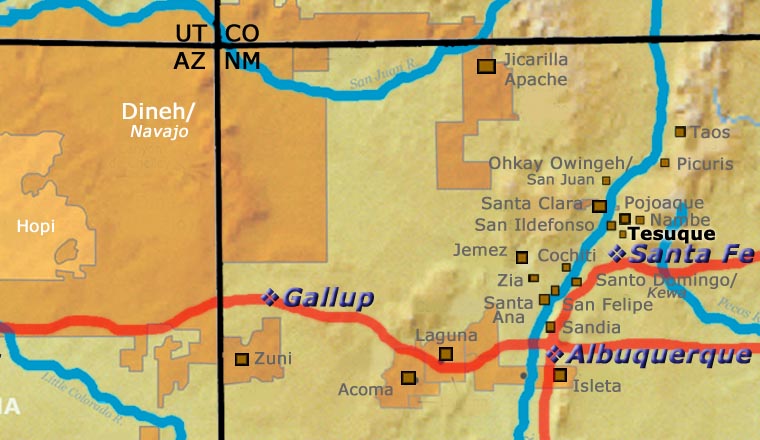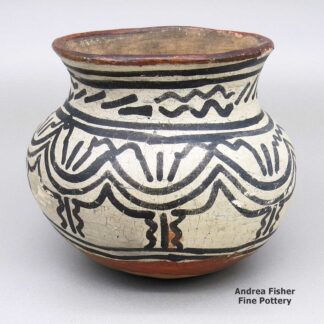Tesuque
A Short History of Tesuque Pueblo

Tesuque Pueblo is located about 10 miles north of today's city of Santa Fe, New Mexico. Archaeologists have dated a few sites in the Tesuque Valley back to about 850 CE. By 1200 CE there were many small villages in the area but when the Spanish arrived in 1540, they found only six villages left. The main Tesuque Pueblo (at that time) was located about 3 miles east of today's pueblo.
During the Pueblo Revolt of 1680, it was a pair of Tesuque runners who misled the Spanish as to when the tribes planned to revolt. The Spanish governor killed the runners for their efforts, then saw many of his Spanish subjects killed when it turned out the "date" their torturing of the runners had gotten them was wrong and the tribes revolted before that.
At Tesuque the warriors killed the local priest and another government official immediately, then marched to the Palace of the Governors in Santa Fe to join with the warriors of other pueblos in that confrontation with the Spanish. A few days later, the Spanish were allowed to leave the Palace of the Governors peacefully and begin the long march south on the Camino Real back to Mexico.
When Don Diego de Vargas returned at the head of Spanish troops (the Conquistadors) in 1692 and began to reconquer northern Nuevo Mexico, one of the first things he had his men do was tear down and burn the main Tesuque village. The tribe quickly officially submitted to Spanish rule, moved to the present pueblo site and began rebuilding in 1694.
Between changes of government, European-introduced diseases, European encroachment on pueblo land and general disregard for the people of the pueblos, the next 200 years were not kind to the Tesuque people and by 1910 the pueblo's population was down to 77.
Today there are about 800 members of the Tesuque tribe living on a reservation of more than 17,000 acres. Among several other businesses, the tribe operates the Tesuque Casino (next to the Santa Fe Opera) and the Camel Rock Suites (on South St. Francis Drive in Santa Fe).

For more info:
Pueblos of the Rio Grande, Daniel Gibson, ISBN-13:978-1-887896-26-9, Rio Nuevo Publishers, 2001
About the Pottery of Tesuque Pueblo
Before the 1800s, Tesuque pottery mostly resembled the pottery produced at San Ildefonso at the time. Around 1830 that began to change as Tesuque potters experimented with newly found clays and slips that shortly made Tesuque Polychrome a style of its own. That style was quite popular until two sisters, Anastasia Romero Vigil and Francisgita Romero Trujillo, are said to have started making muna figures in the mid 1880s. Their decorations evolved much more than their shapes over the years.
Anastasia and Francisgita created a sitting figure holding a pot in his lap, his mouth open and his eyes generally turned to the sky looking for rain. The women started selling them under the portal at the Palace of the Governors in Santa Fe and they turned out to be very popular. Eventually, almost everyone in the pueblo was making them.
Originally, the muna were "funnymakers" who came around to the village three times a year: Christmas Day, New Years Day and Kings Day. They wore masks and painted their faces. Sometimes the men dressed as women. They went door-to-door in the pueblo, making people laugh as they went.
The earliest muna were made of either a micaceous clay paste or a plain buff clay. Then they added a few designs in red paint. Between 1895 and 1915 most decorations were in red and blue. From 1910 to 1930 black designs were added. Pastels were popular from 1930 to 1940, then poster paint was popular from 1940 to about 1970. Then the making of muna figures almost completely stopped.
Around 1905 trader J.S. Candelario named the muna figures "Rain Gods." Then came curio trader Jake Gold. Gold bought so many Rain Gods that nearly everyone in the village was making them. He also convinced them to paint those figurines with commercial paints. Gold did an outstanding marketing job and orders poured in. Soon Tesuque potters were turning out Rain Gods by the thousands. They were distributed nationwide and many manufacturers bought them by the barrel to use as promotional items. That mass production ended up virtually destroying pottery making at Tesuque. In the 1920s the demand for Rain Gods started to diminish and the potters turned to making other low quality goods painted with commercial pastels and "Day-Glo" poster paints.
In the 1930s and early 1940s only a handful of Tesuque potters were producing traditional Tesuque polychrome pottery. Catherine Vigil was one of them.
In 1948, Manuel Vigil was in a car accident and lost a leg. He learned to make pottery while he was recuperating and he and his wife made figurative pottery the rest of their lives. Manuel is credited with making the very first nacimiento.
In the 1960s a few other young potters took up where Catherine left off and a small revival of traditional pottery making began at Tesuque. However, employment in the tribe's commercial ventures these days has pretty much ended most pottery making.
Our Info Sources
Pueblo Indian Pottery, 750 Artist Biographies, by Gregory Schaaf, © 2000, Center for Indigenous Arts & Studies.
Some information may have been gleaned from Pottery by American Indian Women: Legacy of Generations, by Susan Peterson, © 1997, Abbeville Press.
Some info may be sourced from Fourteen Families in Pueblo Pottery, by Rick Dillingham, © 1994, University of New Mexico Press, Albuquerque.
Other info may be derived from personal contacts with the potter and/or family members, old newspaper and magazine clippings, and through interminable searches of the Internet and cross-examination of any results returned.
Data is also checked against the Heard Museum's Native American Artists Resource Collection Online.
If you have any corrections or additional info for us to consider, please send it to: info@andreafisherpottery.com.
Showing the single result
Showing the single result
